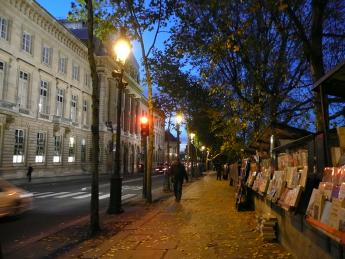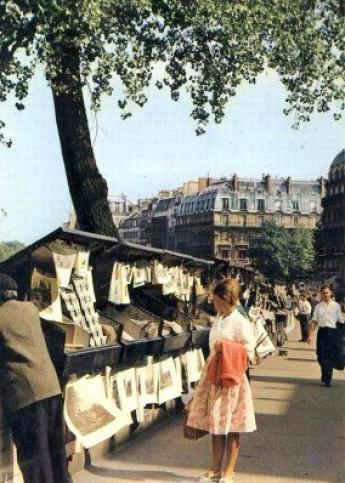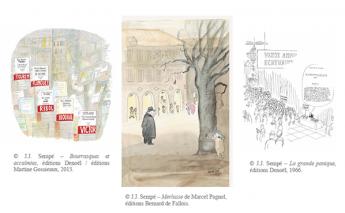Bouquinistes at an ILAB fair - a contradiction? NON!
Since the days of Renaissance, open air bookselling has happened along the Seine riverbanks. Tourist souvenirs aside, a bouquiniste find was often the beginning of a lifelong passion and first piece in a collection. Plying their trade on the famous banks of the Seine, a UNESCO World Heritage site since 1991, the bouquinistes des quais are as emblematic of the French capital as the Eiffel Tower or Montmartre for the millions of French and foreign tourists who visit Paris every year.

Since the days of Renaissance, open air bookselling has happened along the Seine riverbanks. Tourist souvenirs aside, a bouquiniste find was often the beginning of a lifelong passion and first piece in a collection.
Plying their trade on the famous banks of the Seine, a UNESCO World Heritage site since 1991, the bouquinistes des quais are as emblematic of the French capital as the Eiffel Tower or Montmartre for the millions of French and foreign tourists who visit Paris every year.
They will once again be present at the 2017 edition of the fair with the stand run by the Association Culturelle des Bouquinistes de Paris of which the majority of them are members. Founded in 2009 and boasting 182 members, all of whom are “bouquinistes”, the association strives to promote this essential element of Parisian heritage! It is essential to underline the importance and unique nature of this open-air bookselling that has taken place on both banks of the river since the Renaissance. Many a bibliophile purchased the first items in their library from these quayside bouquinistes who are the first link in the chain of antiquarian book stores. These buyers may be children during a Sunday walk with the family or young adults who have “come up” to Paris to study. Some remain loyal customers and still find the time to visit, despite the time-consuming constraints of professional life...
Plying their trade on the famous banks of the Seine, a UNESCO World Heritage site since 1991, the bouquinistes des quais are as emblematic of the French capital as the Eiffel Tower or Montmartre for the millions of French and foreign tourists who visit Paris every year.
They will once again be present at the 2017 edition of the fair with the stand run by the Association Culturelle des Bouquinistes de Paris of which the majority of them are members. Founded in 2009 and boasting 182 members, all of whom are “bouquinistes”, the association strives to promote this essential element of Parisian heritage! It is essential to underline the importance and unique nature of this open-air bookselling that has taken place on both banks of the river since the Renaissance. Many a bibliophile purchased the first items in their library from these quayside bouquinistes who are the first link in the chain of antiquarian book stores. These buyers may be children during a Sunday walk with the family or young adults who have “come up” to Paris to study. Some remain loyal customers and still find the time to visit, despite the time-consuming constraints of professional life...
The bouquinistes perpetuate a centuries-old tradition and can prove to be astonishing repositories of knowledge, despite the fact that the idea of profit has tempted some of them to stray into selling the very basest of tourist souvenirs! While this regrettable situation is somewhat annoying in light of the underlying ethics of the trade, numerous bouquinistes - faithful to the core values of their profession - remain distinguished and devoted booksellers capable of making many a wish come true...
More than 300,000 works can be bought on the banks of the Seine. Passers-by can find not only paperbacks but rare editions, sometimes illustrated, no longer in stock, in the widest range of fields imaginable.
There are currently 81 bouquinistes on the right bank and 141 on the left bank who use those famous green boxes renowned the world over. Of these, 39 can be found in the 1st arrondissement, 42 in the 4th, 67 in the 5th, 62 in the 6th and 12 in the 7th, making a total number of boxes close to 240. The youngest bouquiniste currently working is 24 years old and the oldest 86.
The elder statesman of these intriguing booksellers, who first set up stall in 1961, can be found at 59 du quai de la Tournelle. He has been plying his trade in the open air on the quayside for some 55 years. In terms of parity, there is still some work to be done: 79 women and 143 men.
Which quay has the strongest female presence? The quai Voltaire with 8 women and 4 men. And the strongest male presence? The quai de Conti with 3 women and 16 men...
Historically speaking, it all began with itinerant pedlars who would unpack their goods in the area around the Pont Neuf, the only bridge in Paris that was not built on before the Revolution. Nevertheless, the first definition of the profession of bouquiniste only appeared in the 1723 edition of Savary’s dictionary: “Pauvres libraires qui, n’ayant pas les moyens de tenir boutique ni de vendre du neuf, estaloyent de vieux livres sur le Pont-Neuf, le long des quais et en quelques autres endroits de la ville... ” (Poor booksellers without the means to have a shop or to sell new works, who "estaloyent" old books on the Pont-Neuf, along the quays and in several other locations in the city). They can no longer be found on the Pont Neuf but the city planning work initiated by Napoleon I and completed during the Second Empire extended their scope of activity considerably.
More than 300,000 works can be bought on the banks of the Seine. Passers-by can find not only paperbacks but rare editions, sometimes illustrated, no longer in stock, in the widest range of fields imaginable.
There are currently 81 bouquinistes on the right bank and 141 on the left bank who use those famous green boxes renowned the world over. Of these, 39 can be found in the 1st arrondissement, 42 in the 4th, 67 in the 5th, 62 in the 6th and 12 in the 7th, making a total number of boxes close to 240. The youngest bouquiniste currently working is 24 years old and the oldest 86.
The elder statesman of these intriguing booksellers, who first set up stall in 1961, can be found at 59 du quai de la Tournelle. He has been plying his trade in the open air on the quayside for some 55 years. In terms of parity, there is still some work to be done: 79 women and 143 men.
Which quay has the strongest female presence? The quai Voltaire with 8 women and 4 men. And the strongest male presence? The quai de Conti with 3 women and 16 men...
Historically speaking, it all began with itinerant pedlars who would unpack their goods in the area around the Pont Neuf, the only bridge in Paris that was not built on before the Revolution. Nevertheless, the first definition of the profession of bouquiniste only appeared in the 1723 edition of Savary’s dictionary: “Pauvres libraires qui, n’ayant pas les moyens de tenir boutique ni de vendre du neuf, estaloyent de vieux livres sur le Pont-Neuf, le long des quais et en quelques autres endroits de la ville... ” (Poor booksellers without the means to have a shop or to sell new works, who "estaloyent" old books on the Pont-Neuf, along the quays and in several other locations in the city). They can no longer be found on the Pont Neuf but the city planning work initiated by Napoleon I and completed during the Second Empire extended their scope of activity considerably.
Before the First Empire, very few quays in Paris were faced with stone and some, such as the quai Saint-Michel, had buildings on them preventing sellers from unwrapping their goods... The landscape familiar to us dates from only the 19th century. It was nevertheless not until the municipal decree of 1891 that the bouquinistes’ boxes, and thus the quays, could take on the shape that we now know and love, with the big boxes measuring 2 metres long and 75 centimetres deep. In the past, the bouquinistes could not leave their goods on the parapet overnight. The books were brought to the selling place in the morning in easily carried boxes and stored overnight in a shed. In 1857, there were 68 permit holders. This figure rose to 75 in 1865, 156 in 1892 and 204 in 1920, including 97 women...
Today, the quays remain a unique place for strolling around, where passers-by can make some remarkable discoveries. The hunting ground of cash-strapped students and experienced bibliophiles alike, the quays constantly reveal amazing surprises which amply justify, as if any justification were required, such keen interest.
For the 2017 fair, Mr Jean-Jacques Sempé has agreed to be the guest of honour at our stand (E4). The bouquinistes are thus particularly proud and pleased to present an exceptional collection of his original drawings on the theme of books. A great moment of happiness and poetry...
Jérôme Callais, bouquiniste
For more information:
bouquinistesdesquais@laposte.net
to contact the President of the association, Jérôme Callais,
the Treasurer, Sylvie Mathias
and the Secretary, Michel Bouetard
The 2017 Salon International du Livre Rare Paris is organised by the French Booksellers Association, SLAM and runs from 7 - 9 April 2017.
Today, the quays remain a unique place for strolling around, where passers-by can make some remarkable discoveries. The hunting ground of cash-strapped students and experienced bibliophiles alike, the quays constantly reveal amazing surprises which amply justify, as if any justification were required, such keen interest.
For the 2017 fair, Mr Jean-Jacques Sempé has agreed to be the guest of honour at our stand (E4). The bouquinistes are thus particularly proud and pleased to present an exceptional collection of his original drawings on the theme of books. A great moment of happiness and poetry...
Jérôme Callais, bouquiniste
For more information:
bouquinistesdesquais@laposte.net
to contact the President of the association, Jérôme Callais,
the Treasurer, Sylvie Mathias
and the Secretary, Michel Bouetard
The 2017 Salon International du Livre Rare Paris is organised by the French Booksellers Association, SLAM and runs from 7 - 9 April 2017.
For more information, please visit the Paris website!


